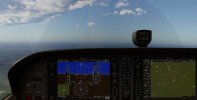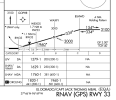I guess it is enough of a risk that could result in certificate action for NBAA (and the FAA) to point out what could go wrong by mindlessly following the glide slope prior to the published intercept altitude.
It seems to have snared a few professional pilots who presumably knew better.
I agree with
@midlifeflyer that your inclusion of the word "mindlessly" is key. The NBAA and FAA InFO letter that you posted are absolutely correct, there IS a risk of violating an altitude limitation, typically if it's a hot day and therefore your indicated altitude on the glideslope at a certain fix will be lower than it would be on a normal day (since ILS and LPV glideslopes are fixed, and aren't affected by temperature). So yes, you can bust a stepdown fix minimum altitude if you're not paying attention. But the vast majority of ILS and LPV approaches do not have stepdown fixes in the intermediate segment, so it's not a concern for those procedures. Where it is a potential concern, as the letters state, is at busy airports which often have many stepdown fixes prior to the FAF (see KLAX ILS OR LOC RWY 24R as an example).
Mark, to your question, all fixes in the intermediate segment are required to be below a 3 degree glidepath (technically, the wording is that they have to provide less than a 318 ft per nm descent gradient to the FAF, which is 3 degrees). This is the current rule, and it has changed slightly over the years, but I don't recall it ever allowing a descent gradient HIGHER than the published glidepath. Trouble is, non-standard temperatures can cause the pilot's indicated altitude (the one that is used for traffic deconfliction) to be LESS than published, if those fixes are indeed published right on glidepath.
The KLAX ILS OR LOC RWY 24R also provides an example of another potential pitfall - cleverness with the fix types. If you look at it, the IF is MERCE, which is the last fix before the FAF. Therefore, the intermediate segment is JUST MERCE to KOBEE. All the previous fixes are therefore part of the initial segment, NOT the intermediate. This is important because the maximum descent gradient in the initial segment is 500 ft/nm, NOT the shallower 318. Meaning that fixes in the initial could potentially be ABOVE the glidepath. I do not believe this is the case at LAX, as they all appear to be below glidepath, and it would be a lousy design anyway with few potential advantages and lots of disadvantages.
But, as said previously, the vast majority of approaches do not have stepdown fixes in final, so with a little bit of care, you can feel free to intercept the glideslope/path outside the FAF all you want to (and, I'd say, most IFR pilots probably do). No sense in descending, leveling off, and powering up just to reconfigure a minute later and start the descent all over again.



